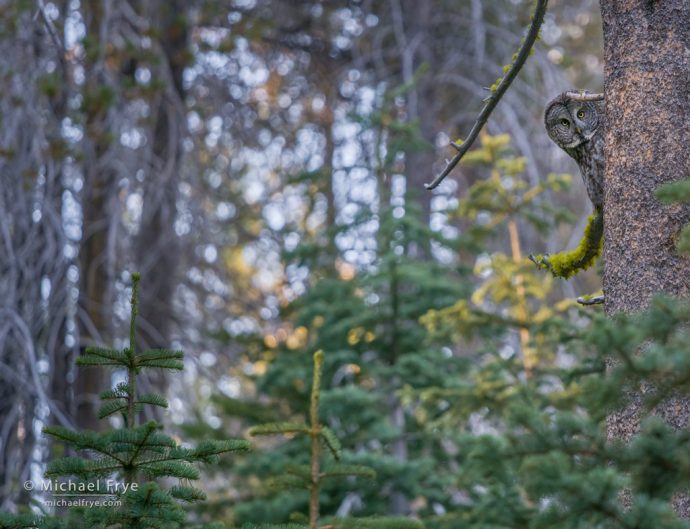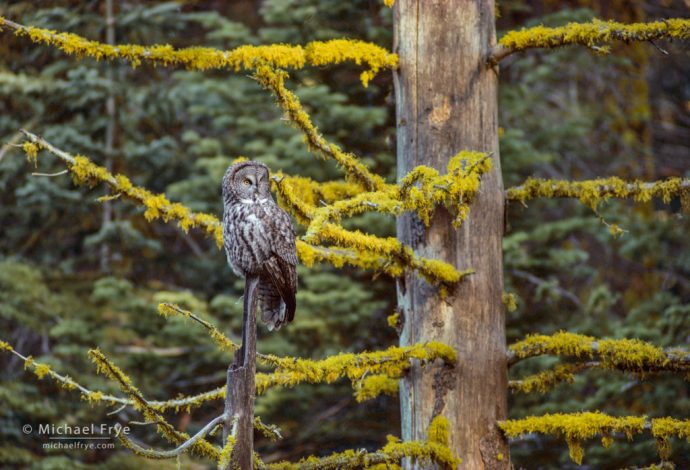
Great gray owl, Yosemite. This was what my first view looked like as the owl as craned its neck around the trunk and stared back at me.
Claudia and I have made several trips to the Yosemite high country recently to photograph flowers. We’ve mostly seen early bloomers like shooting stars, along with a few other species.
One afternoon we made a short hike to one of the high-country meadows looking for flowers. Whenever I’m near meadows in Yosemite between, say, 6,000 and 8,000 feet, I keep my eyes and ears peeled for great gray owls. These are the largest owls in North America, and typically live in boreal forests in Canada and Alaska. But some live in the Cascades and northern Sierra, all the way down to Yosemite, which hosts the southern-most population of these birds.
Great grays don’t just hunt at night; they sometimes hunt in the early morning and late afternoon. But despite their size and diurnal hunting habits they can be incredibly elusive. I’ve seen them about a dozen times in total, but mostly back in the late ’80s and early ’90s when I did a lot of wildlife photography. It had been at least ten years since I last saw one.
At one point, walking along the edge of the meadow, I heard jays and robins making a ruckus in the woods nearby. Smaller birds will often “mob” predators, like owls, to let everyone in the neighborhood know that there’s a dangerous character nearby. Sometimes it can be hard to distinguish such mobbing behavior from normal bird noises; jays, for example, often squabble with each other, which can sound a lot like jays mobbing a predator.
But on this occasion the birds were making such a commotion that there could be no doubt that they had found a predator. And given the habitat, I was 99% sure it was a great gray owl.
The woods between me and the mobbing birds, however, were full of fallen trunks and limbs, making it difficult to make a quiet approach. Then the sounds moved, following the apparent flight of the presumed owl. I zeroed in on the new location of the mobbing, further down the meadow. Claudia was photographing some flowers, and I asked her if she wanted to come with me. At first she hesitated, absorbed in her photography. I said, “Don’t you want to see a great gray?” She said, “Yes, I do,” and followed behind me.
Again I found a thicket of branches between me and the commotion. Then the calls changed, indicating that the owl was moving again, and this time I caught a split-second glimpse of a large bird flying through the trees.
Once more, Claudia and I followed the bird calls. By then the jays and robins seemed to be getting tired of harassing the owl, and by the time I zeroed in on the location there was just one lone robin chirping. But that was enough. Luckily this time the calls were coming from a spot closer to the meadow, and there was a small bay where the meadow extended up into the forest. I moved slowly, scanning the trees carefully. I found the robin about 30 feet up in a tree, and knew that the robin would never position itself below the owl, so the owl had to be even lower. And close by.
Moving slowly, scanning the trees, I spotted a dark shape next to a trunk. I raised my binoculars, and saw a great gray owl craning its neck around the trunk, staring right at me. Damn, what a sight.
I motioned for Claudia to come join me, and pointed out where the owl was. She whispered, “I see it! It’s looking right at us!”
At first I was content to just look. But then I decided to get out my camera. I only had a 200mm lens, and the light wasn’t great, but at least I could document the sighting. I took a few photos as the owl stared back at me. It looked down, focusing on a sound below, looked back at me, then looked down again. I gradually moved a little closer, but my path then became blocked by a shrub. We probably watched the owl for about 15 minutes before it flew a short distance to another tree. Here’s Claudia’s video of that moment:
(If you’re viewing this post as an email, click here to see the video.)
We could have followed the owl to its new perch, but decided to leave it in peace. It was starting to get dark anyway.
The photographs turned out better than I expected (though they needed considerable cropping). But that was secondary. Just seeing the owl made our day, if not our whole week. What a thrill.
— Michael Frye
P.S. Here’s another great gray owl photo that I made in 1986 with a 300mm lens and 35mm film. I had seen my first ever great gray owl two days earlier in this same area. The night before I made this photograph I had a dream in which I was photographing a great gray owl surrounded by branches covered with staghorn lichen. The next morning I found this owl hunting along the edge of a meadow. It flew to another nearby small meadow, and I followed it. I slowly worked my way along the edge of this small meadow until I spotted the owl. I crept along, trying to get a better view, with my camera on my tripod, at the ready. Then I stopped in my tracks, as I realized that from where I was standing the owl was surrounded by branches covered in staghorn lichen – just like in my dream.
Related Posts: First Snowfall; Telling a Visual Story
Michael Frye is a professional photographer specializing in landscapes and nature. He is the author or principal photographer of The Photographer’s Guide to Yosemite, Yosemite Meditations, Yosemite Meditations for Women, Yosemite Meditations for Adventurers, and Digital Landscape Photography: In the Footsteps of Ansel Adams and the Great Masters. He has also written three eBooks: Light & Land: Landscapes in the Digital Darkroom, Exposure for Outdoor Photography, and Landscapes in Lightroom: The Essential Step-by-Step Guide. Michael has written numerous magazine articles on the art and technique of photography, and his images have been published in over thirty countries around the world. Michael has lived either in or near Yosemite National Park since 1983, currently residing just outside the park in Mariposa, California.










Great shots! And that wing span in C’s video! What a dream capture!
Yeah, I was impressed with the wing span too. I even said something to Claudia about it, but you can’t hear it on the video.
Wonderful. Thank
You!
Thanks Carroll!
Great captures Michael.
Thanks Terry!
How exciting!
Indeed Bev!
Fascinating, Michael Frye!
I saw this through a link posted in the California sign. I would like to permission to draw And possibly paint from your photo.
Thanks Valerie! Sorry, but as a rule, I don’t give permission for people to paint my photos. I just don’t have any way to control how those paintings are used.
Wow!! Great story, thanks for sharing!
Thanks Marcia!
Great story, I really enjoyed it. It’s good to see you do wildlife photography too when you find an interesting animal. I love the pictures as well, especially the “old” one. I’m guessing it was shot on Kodachrome, right?
Thanks Gabor! Probably Kodachrome, yes.
How exciting! What a thrill to see one of these beautiful birds in its natural habitat. Thanks for the great story, Michael.
Thank you Bob!
Mike,
Great shots, and more importantly, great story. Your description made me think of mobbing birds in my area, and they’re usually red tailed hawks. I’m inspired by the story and shots as I’ve only been able to see owls in captivity so far, but I look forward to seeing one in the wild! Thanks for the share.
Thanks Scott! There are owls everywhere, so keep paying attention to those mobbing birds and they might lead you to an owl.
Incredible owl story, Michael! I know how special that would have been to be so close and to see something so rare in our beloved Sierra. Thanks for sharing your experience and photo so that we might feel the thrill vicariously.
Thanks very much Brenda! I’m glad you enjoyed this.
Great shot! I love your playing peek-a-boo with the great gray owl! I found one in May at Yellowstone. He was far away in a tree, and I didn’t have my tripod ready. Not my best work, but here is what I came up with. See what you think:
ArtistsEyeImages.com/great-gray-owl
Thanks Stuart! I’m glad you got to see and photograph a great gray. The composition and pose in your photo are both very good, though it’s too bad there’s that little branch in front of its eye. The biggest issue is the lack of sharpness.
Thanks for your comments, Michael. I totally agree with you. Hand holding my Tamron 100-400mm at 400mm even with stabilization was beyond my skill level I’m afraid. I could hardly see the owl at 400mm. I guess I should have tried to get closer (or use a tripod). There were a bunch of people there taking photos from higher ground. I would have had to climb down to get closer, and if I scared the owl off, I probably would have got mobbed 🙂
Yes, you would have been mobbed for sure. Grizzlies aren’t the only dangerous animals in Yellowstone. 🙂
Beautiful birdie! I saw a video recently of a person petting one of these. Whenever the person would stop, the bird got visibly disappointed. There’s probably a much better way I could have said all that but I’m still quite dumbstruck!
Well I didn’t know that owls liked to be pet, but then that doesn’t really surprise me. Why not?
Especially head scratches. They actually roll their eyes like we do! YouTube has a video entitled kitty Malay eagle owl.
I am going to find the GGO in Yosemite. Would love to see the majestic bird again!
I saw this special on PBS on the flight characteristics of the gray owls and it was very informative. What was most fascinating was that they were silent gliders if not flyers. I would love to see it again and will seek it out. Thanks for your article and photos
Cool. ALL owls are silent flyers – pretty amazing.